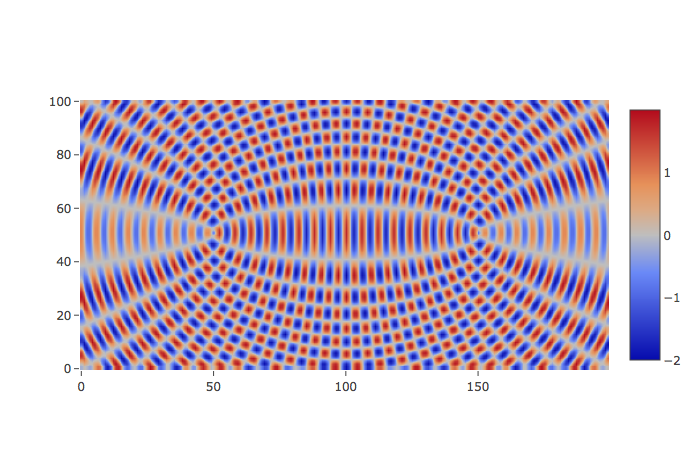
本人在学习使用 plotly 的 contour plots 制作的时候,发现利用这个表格制作波的干涉模拟方面有很不错的效果,因为之前被各种波动方程和振动方程教育了很久,所以就用波函数来开动,下面分享代码,供大家参考。(我用 java 写的代码模拟的波函数的测试数据)
下面是 plotly 的全部代码,里面包含了两种生成 contour plots 图表的方式,一个生成的是单个图表,但是带着等高线,所以被我放弃了。另外一个生成是图表矩阵,我选的 row=1,cols=1 的模式。
#!/usr/bin/python
# coding=utf-8
import plotly.plotly
from plotly.graph_objs import *
import plotly.graph_objs as go
import plotly.tools as tool
z = []
with open("/Users/Vicky/Documents/workspace/fission/long/intervene.log") as apidata:
for i in apidata:
data = i.split("\n")[0].split(",")
z.append(data)
'''
#这是单独一个表格的情况,但没找到去掉等高线的方法
data = Data([
Contour(
z=z,
contours = dict(
coloring="heatmap"
)
)
])
plotly.offline.plot(data,filename="3333.html")
'''
data = {
'z': z,
'connectgaps': True,
'type': 'heatmap',
'zsmooth': 'best',
'showscale': True
}
fig = tool.make_subplots(rows=1, cols=1)
fig.append_trace(data, 1, 1)
plotly.offline.plot(fig,filename= "3333.html")
下面是 java 生成数据的代码:
package practise;
import java.awt.Point;
import java.util.ArrayList;
import java.util.List;
import source.SourceCode;
public class Intervene extends SourceCode {
public List<List<Double>> data = new ArrayList<>();
public static void main(String[] args) {
Intervene intervene = new Intervene();
intervene.testDemo001();
}
public void testDemo001() {
Point point1 = new Point(50, 50);
Point point2 = new Point(150, 50);
int lamda = 6;
for (int i = 0; i < 100; i++) {// y 轴
List<Double> distance = new ArrayList<>();
for (int j = 0; j < 200; j++) {// x 轴
Point point = new Point(j, i);
double x = point.distance(point1) % lamda / lamda;
double y = point.distance(point2) % lamda / lamda;
double xx = Math.sin(x * 2 * Math.PI);
double yy = Math.sin(y * 2 * Math.PI);
distance.add(xx + yy);
}
data.add(distance);
}
StringBuffer content = new StringBuffer();
int size = data.size();
for (int i = 0; i < size; i++) {
String text = data.get(i).toString();
text = text.substring(1, text.length() - 1);
if (i == 0)
content.append(text);
content.append(LINE + text);
}
logLong("intervene.log", content.toString());
}
}
下面是生成图表:

